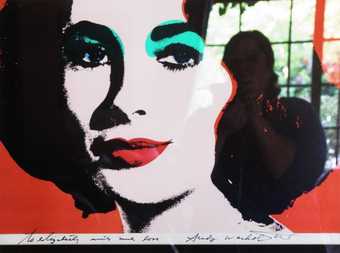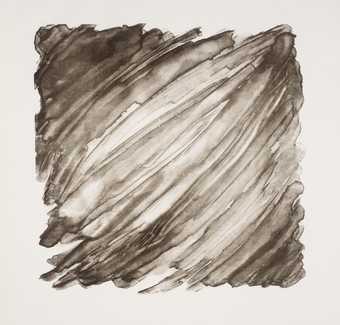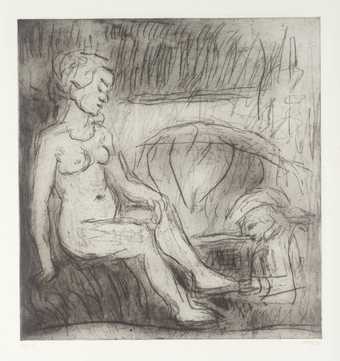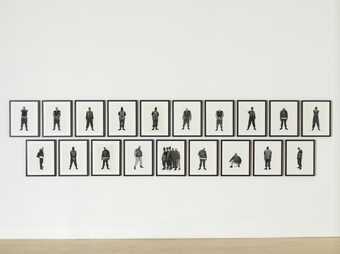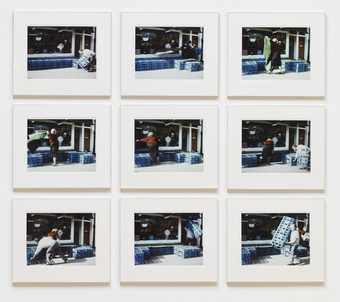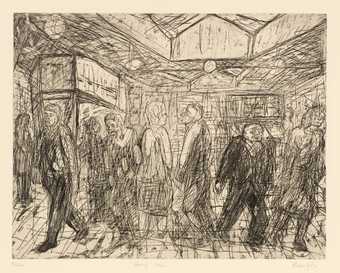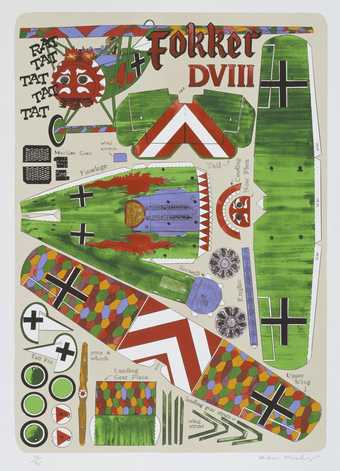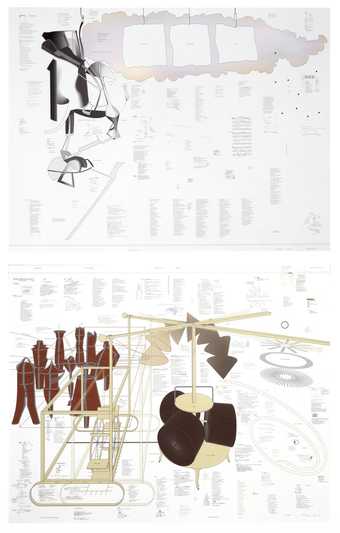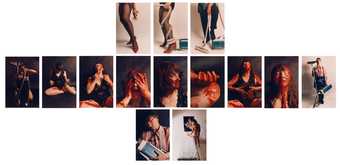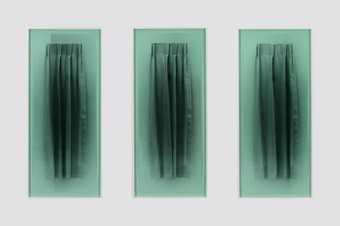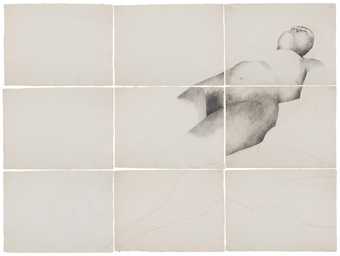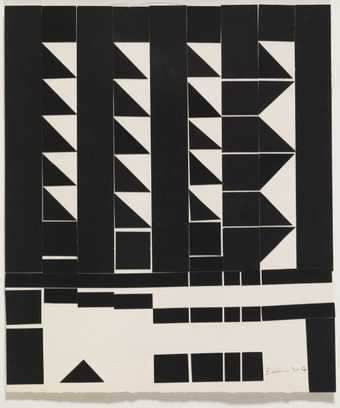In Tate Liverpool
- Artist
- Zarina Hashmi 1937 – 2020
- Medium
- 8 woodblock and metalcut prints on paper
- Dimensions
- Image, each: 570 × 380 mm
- Collection
- Tate
- Acquisition
- Purchased with funds provided by the South Asia Acquisitions Committee 2013
- Reference
- P80181
Summary
Letters from Home is a portfolio of eight monochromatic woodblock and metalcut prints, produced using original letters written in Urdu to Zarina Hashmi by her sister Rani. From the letters, the artist made printing plates which she used to print onto handmade Kozo paper. The letter imprint was then surrounded or overlaid by the outline of a house, a floor plan or the map of a geographical location, using a woodblock print. Hashmi printed the works herself, publishing the portfolio in an edition of twenty, of which Tate’s copy is number nine.
Hashmi studied printmaking with the renowned English painter and printmaker S.W. Hayter (1901–1988) at Atelier 17 in Paris from 1963 to 1967, and Letters from Home reflects her training across a variety of printmaking techniques. The series was made in Hashmi’s New York studio in 2004. As the title indicates, Letters from Home acts as a preserved archive of the letters sent to Hashmi by her sister over a period of time. Since her departure from India in 1958 to accompany her husband Saad Hashmi, a military officer engaged in international diplomacy, in his travels around the world, the artist has moved frequently between cities, countries and continents. Immediately after her departure, her family was required to relocate due to the partition of India and Pakistan, resulting in the loss of the family home. They moved from Delhi in India to Karachi in Pakistan, where Hashmi’s sister still lives. As a consequence, themes of the house and home play an important part in Hashmi’s work. She has said: ‘Home is the centre of my universe; I make a home wherever I am.’ (Zarina Hashmi, ‘A Conversation with Zarina in New York with Geeti Sen’, in Gallery Espace 2006, p.13.)
Letters from Home draws on a range of sources, from Hashmi’s childhood home in pre-partition India to her sojourns across the world. The portfolio functions as a series of maps that trace the artist’s journeys and record the places in which she has lived. Working with actual geographical locations, Hashmi acts as cartographer, preserving communication from her sister within the sites of her own memories. Homes, floor plans and routes are printed onto the letters, presenting Hashmi’s life as an atlas, one that is both a universal document and a record of personal experience.
Through the representation of memories in Letters from Home, Hashmi creates a place of shelter in a foreign land. She has said: ‘Home is always an interior reality, which, with a floor plan, I can walk through again and again in my imagination.’ (Zarina Hashmi, ‘54th Venice Biennale: Zarina Hashmi (India)’, ART iT, June 2011, paragraph 9, http://www.art-it.asia/u/admin_ed_feature_e/FHt6zkTwqhKfNOJcUbuV/, accessed 6 July 2012.) While functioning as an inventory of Hashmi’s life experiences, Letters from Home also serves as a poignant reminder of her dislocated status. It reveals her experience of being distanced from home and loved ones, and functions as a diary of the activities of the family she left behind.
Text plays a key role in Hashmi’s work and the inclusion of characters written in her native Urdu acts as a reminder of the geo-political specificity of her cultural heritage and identity. The Partition of India not only dislodged the physical connection of north Indian Muslim families to a particular place, but it also disrupted a sophisticated cultural milieu. Hashmi has said: ‘The words are in my own language, recalling a time, a sensibility of thought and feeling.’ (Zarina Hashmi, ‘A Conversation with Zarina in New York with Geeti Sen’, in Gallery Espace 2006, p.13.) In light of the relative decline of the literary form of Urdu in parlance in pre-partition India, Letters from Home acts as an assertion of personal identity and a statement of post-partition defiance.
Further reading
Zarina: Paper Houses, exhibition catalogue, Gallery Espace, New Delhi 2007.
Zarina Hashmi: Noor, exhibition catalogue, Galerie Jaeger Bucher, Paris 2011.
Allegra Pesenti, Zarina: Paper Like Skin, Los Angeles 2011, reproduced pp.134–7.
Hannah Dewar
August 2012
Does this text contain inaccurate information or language that you feel we should improve or change? We would like to hear from you.
Display caption
This series of prints is based on letters written by the artist’s sister who lived in Pakistan. Lines of handwritten prose in Urdu are overlaid and obscured with maps and blueprints of distant homes and places. The letters mark significant moments – the death of a parent, for instance – and some of the prints bear impressions of places relevant to their estranged lives. Hashmi maps and conveys the experience of loss and dispossession due to political conflict. The break with the Urdu literary culture of undivided India is poignant for the artist who was born in Aligarh, a university town and centre of learning.
Gallery label, April 2013
Does this text contain inaccurate information or language that you feel we should improve or change? We would like to hear from you.
Features
-
Tate Etc
You might like
-
Catherine Opie 700 Nimes Road
2010–11, printed 2014 -
Kim Lim Black Wash
1993 -
Kim Lim B
1995 -
Leon Kossoff Bathsheba Reading David’s Letter
1998 -
Faisal Abdu’Allah I Wanna Kill Sam Cause He Ain’t My Motherfuckin’ Uncle
1993, printed 2010 -
Michael Landy CBE RA Appropriation 3
1990 -
Leon Kossoff Going Home
1984 -
Malcolm Morley Fokker DVIII
2001 -
Richard Hamilton Typo/Topography of Marcel Duchamp’s Large Glass
2003 -
Jo Spence Libido Uprising Part I and Part II
1989 -
Becky Beasley Curtains (I), (II), (III)
2009 -
Sutapa Biswas To Touch Stone
1989–90 -
Zarina Hashmi Untitled
2017 -
Mari Katayama I’m wearing little high heels, I have child’s feet
2011, printed 2018


